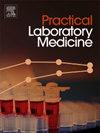生物素在常规临床免疫分析中的干扰
IF 1.7
Q3 MEDICAL LABORATORY TECHNOLOGY
引用次数: 0
摘要
实验室检查在医学诊断和治疗中起着至关重要的作用,需要识别干扰因素以确保准确的结果。生物素,一种常见的膳食补充剂,可以干扰利用生物素-链亲和素相互作用的免疫测定。研究已经证明生物素对甲状腺功能测试和各种免疫分析的显著影响,促使需要有效的缓解策略。方法采集临床各科室标本,进行生物素水平分析。使用新旧Elecsys试剂对甲状腺球蛋白(TG)、甲胎蛋白(AFP)、抗甲状腺球蛋白(ATG)和游离甲状腺素(FT4)的检测进行生物素干扰评价。生物素峰值和消耗试验进行评估干扰缓解方法。此外,比较了罗氏和雅培免疫测定系统的生物素耐受性。结果78名受试者分别来自不同临床科室:健康管理中心(n = 13)、急诊科(n = 21)、重症监护病房(n = 12)、妇科(n = 3)、血液透析科(n = 29)。与其他患者组相比,接受血液透析的患者和重症监护病房(ICU)患者的生物素水平显著升高(平均分别为3.282 ng/mL和3.212 ng/mL) (p <;0.05),可能是由于摄入了含生物素的补充剂。生物素水平(500 ng/mL)导致测定值变化20%,使用较旧的Elecsys试剂,导致TG和AFP的假低结果和ATG和FT4的假高结果。将10%的变化作为阈值,较新的Elecsys试剂显示出对生物素干扰的抗性增强,根据具体测试,耐受浓度为1000 ng/mL至3000 ng/mL,与罗氏说明书一致。我们采用了一种生物素耗尽法,有效地恢复了旧试剂的测定准确性,当生物素水平低于400 ng/mL时,通常导致不到10%的变化。然而,由于新试剂的生物素耐受性增加,这种消耗方法是不必要的。比较罗氏和雅培系统揭示了生物素耐受性的显著差异。雅培系统对生物素干扰表现出更强的弹性,而罗氏系统在癌胚抗原、癌抗原125、癌抗原153、癌抗原19-9的检测中显示出生物素干扰,在500 ng/mL生物素时变化超过30%。结论我们的研究突出了血液透析和ICU患者中生物素水平升高的高发率,为临床结果解释提供了重要参考。我们证实罗氏的新试剂表现出增强的生物素耐受性,与制造商的声明一致,并证明生物素耗尽有效地恢复了测定准确性。这些发现为减轻临床免疫测定中的生物素干扰提供了有价值的方法学指导。本文章由计算机程序翻译,如有差异,请以英文原文为准。
Biotin interference in routine clinical immunoassays
Background
Laboratory examinations play a crucial role in medical diagnostics and treatment, necessitating the identification of interference factors to ensure accurate results. Biotin, a common dietary supplement, can interfere with immunoassays utilizing biotin-streptavidin interactions. Studies have documented biotin's significant impact on thyroid function tests and various immunoassays, prompting the need for effective mitigation strategies.
Methods
Samples were collected from various clinical departments and analyzed for biotin levels. Biotin interference was evaluated using both old and new Elecsys reagents in assays for thyroglobulin (TG), alpha-fetoprotein (AFP), anti-thyroglobulin (ATG), and free thyroxine (FT4). Biotin spike-in and depletion tests were conducted to assess interference mitigation methods. Additionally, the biotin tolerance of Roche and Abbott immunoassay systems was compared.
Results
Biotin levels were measured in 78 participants from different clinical departments: health management center (n = 13), emergency department (n = 21), intensive care unit (n = 12), gynecology department(n = 3), and hemodialysis department (n = 29). Patients undergoing hemodialysis and those in the intensive care unit (ICU) demonstrated significantly elevated biotin levels (mean = 3.282 ng/mL and 3.212 ng/mL, respectively) in comparison to other patient groups (p < 0.05), likely attributable to the intake of biotin-containing supplements. Biotin levels >500 ng/mL caused a 20 % change in assay values, resulting in false-low results for TG and AFP and false-high results for ATG and FT4 with older Elecsys reagents. Setting a 10 % change as the threshold, the newer Elecsys reagents demonstrated improved resistance against biotin interference, tolerating concentrations of 1000 ng/mL to 3000 ng/mL depending on the specific tests, consistent with the Roche package inserts. We employed a biotin depletion method that effectively restored assay accuracy for older reagents, generally resulting in less than a 10 % change when biotin levels were below 400 ng/mL. However, this depletion method was unnecessary with the newer reagents due to their increased biotin tolerance. Comparing the Roche and Abbott systems revealed significant differences in biotin tolerance. The Abbott system demonstrated greater resilience to biotin interference, while the Roche system showed biotin interference in assays for carcinoembryonic antigen, cancer antigen 125, cancer antigen 153, cancer antigen 19-9, with changes exceeding 30 % at 500 ng/mL of biotin.
Conclusions
Our study highlights the high prevalence of elevated biotin levels in hemodialysis and ICU patients, serving as a critical reference for clinical result interpretation. We confirm that Roche's newer reagents exhibit enhanced biotin tolerance, consistent with the manufacturer's claims, and demonstrate that biotin depletion effectively restores assay accuracy. These findings provide valuable methodological guidance for mitigating biotin interference in clinical immunoassays.
求助全文
通过发布文献求助,成功后即可免费获取论文全文。
去求助
来源期刊

Practical Laboratory Medicine
Health Professions-Radiological and Ultrasound Technology
CiteScore
3.50
自引率
0.00%
发文量
40
审稿时长
7 weeks
期刊介绍:
Practical Laboratory Medicine is a high-quality, peer-reviewed, international open-access journal publishing original research, new methods and critical evaluations, case reports and short papers in the fields of clinical chemistry and laboratory medicine. The objective of the journal is to provide practical information of immediate relevance to workers in clinical laboratories. The primary scope of the journal covers clinical chemistry, hematology, molecular biology and genetics relevant to laboratory medicine, microbiology, immunology, therapeutic drug monitoring and toxicology, laboratory management and informatics. We welcome papers which describe critical evaluations of biomarkers and their role in the diagnosis and treatment of clinically significant disease, validation of commercial and in-house IVD methods, method comparisons, interference reports, the development of new reagents and reference materials, reference range studies and regulatory compliance reports. Manuscripts describing the development of new methods applicable to laboratory medicine (including point-of-care testing) are particularly encouraged, even if preliminary or small scale.
 求助内容:
求助内容: 应助结果提醒方式:
应助结果提醒方式:


